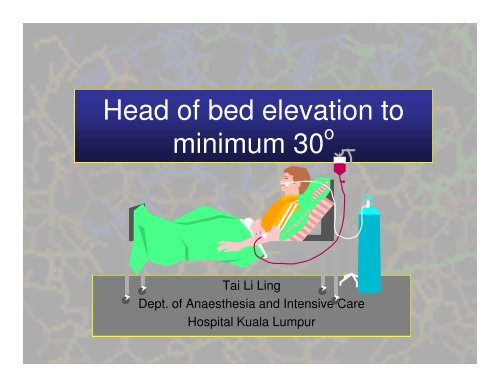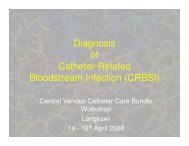Head of bed elevation to minimum 30 - MRIC
Head of bed elevation to minimum 30 - MRIC
Head of bed elevation to minimum 30 - MRIC
Create successful ePaper yourself
Turn your PDF publications into a flip-book with our unique Google optimized e-Paper software.
<strong>Head</strong> <strong>of</strong> <strong>bed</strong> <strong>elevation</strong> <strong>to</strong><br />
<strong>minimum</strong> <strong>30</strong> o<br />
Tai Li Ling<br />
Dept. <strong>of</strong> Anaesthesia and Intensive Care<br />
Hospital Kuala Lumpur
Ventila<strong>to</strong>r-associated<br />
pneumonia<br />
is associated with pulmonary<br />
aspiration <strong>of</strong> gastric contents,<br />
oropharyngeal or nasopharyngeal<br />
secretions
Ventila<strong>to</strong>r-associated<br />
pneumonia<br />
� MYTH: Aspiration does not occur when<br />
the patient is intubated with the tracheal<br />
tube cuff inflated<br />
� FACT: Aspiration can occur even when<br />
the cuff <strong>of</strong> the tracheal tube is inflated
Ventila<strong>to</strong>r-associated<br />
pneumonia<br />
Kollef M: Ventila<strong>to</strong>r-associated pneumonia: A multivariate analysis.<br />
JAMA 1993; 270: 1965-1970<br />
� supine position is an important independent<br />
risk fac<strong>to</strong>r for VAP<br />
� higher mortality in patients in the supine<br />
position (<strong>30</strong>.2%) than in those in the semirecumbent<br />
(8.9%) position
Supine vs. semi-recumbent position in<br />
mechanically ventilated patients<br />
� Torres A et al: Pulmonary aspiration <strong>of</strong> gastric contents in patients<br />
receiving mechanical ventilation: The effect <strong>of</strong> body position. Ann<br />
Intern Med 1992; 116: 540-543<br />
� Ibanez J et al: Gastroesophageal reflux in intubated patients<br />
receiving enteral nutrition: Effect <strong>of</strong> supine and semirecumbent<br />
positions. J Parenter Enteral Nutr 1992; 16:419-422<br />
� Orozco-Levi Met al: Semirecumbent position protects from<br />
pulmonary aspiration but not completely from gastroesophageal<br />
reflux in mechanically ventilated patients. Am J Respir Crit Care<br />
Med 1995; 152: 1387-1390
Supine vs. semi-recumbent position in<br />
mechanically ventilated patients<br />
higher levels <strong>of</strong> pulmonary aspiration <strong>of</strong><br />
radioactive-labeled gastric contents in the<br />
supine position than in the semi- semirecumbent<br />
position.
Supine vs. semi-recumbent position in<br />
mechanically ventilated patients<br />
Drakulovic MB et al: Supine body position as a risk fac<strong>to</strong>r for<br />
nosocomial pneumonia in mechanically ventilated patients: A<br />
randomized trial. Lancet 1999; 354: 1851-1858<br />
� 86 mechanically ventilated patients<br />
� elevating the HOB ><strong>30</strong>o � elevating the HOB ><strong>30</strong> was assoc.<br />
o was assoc.<br />
- 26% absolute risk reduction <strong>of</strong> clinically<br />
suspected nosocomial pneumonia<br />
- 18% absolute risk reduction in aspiration<br />
pneumonia
Supine vs. semi-recumbent position in<br />
mechanically ventilated patients<br />
Grap MJ. Effect <strong>of</strong> backrest <strong>elevation</strong> on the development <strong>of</strong> VAP.<br />
Am J Crit Care 2005(14)4:325-32<br />
� No direct association between height <strong>of</strong> backrest<br />
and VAP<br />
��<br />
VAP more likely in the more severely ill and who<br />
spent greater time with backrest <strong>elevation</strong> < <strong>30</strong> 0<br />
during the first day <strong>of</strong> intubation
Position <strong>of</strong> critically ill<br />
Kollef M. Ventila<strong>to</strong>r-associated pneumonia: a multivariate analysis.<br />
JAMA. 1993;270(16):1965–1970<br />
� 32.1% in the supine position<br />
�� no clear indication for supine position
Position <strong>of</strong> critically ill<br />
Evans D. The use <strong>of</strong> position during critical illness: current practice and<br />
review <strong>of</strong> the literature. Aust Crit Care. 1994; 7:16-21<br />
� 113 patients, position descri<strong>bed</strong> at a single point<br />
�� 48% in supine, 27% right lateral, 25% left lateral<br />
� mean backrest <strong>elevation</strong> 23 o<br />
� significant negative correlation (r=-0.41) between<br />
APACHE II score and degree <strong>of</strong> <strong>elevation</strong>
Position <strong>of</strong> critically ill<br />
Grap MJ, et al. Use <strong>of</strong> backrest <strong>elevation</strong> in critical care: a pilot study. Am J<br />
Crit Care. 1999;8(1):475–480<br />
� 86% <strong>of</strong> patients in the supine position<br />
� mean backrest position was 22.9o � mean backrest position was 22.9<br />
� position not related <strong>to</strong> enteral feedings or <strong>to</strong> blood<br />
pressure readings<br />
� no change in haemodynamic status in semi-recumbent<br />
positioning<br />
� rationale for supine positioning was attributed <strong>to</strong><br />
convenience, patient comfort, and usual practice in the<br />
unit
Position <strong>of</strong> critically ill<br />
Cook DJ et al. Toward understanding evidence uptake:<br />
semirecumbency for pneumonia prevention. Crit Care Med<br />
2002:<strong>30</strong>(7):1472-1477<br />
� qualitative study using semi-structured interviews<br />
and focus groups<br />
� insufficient awareness <strong>of</strong> its benefit, real and<br />
perceived deterrents, poor agreement about<br />
implementation responsibility, and lack <strong>of</strong><br />
enabling/ reinforcing strategies
Cognitive fac<strong>to</strong>rs operate at level <strong>of</strong> individual healthcare provider<br />
Environmental determinants<br />
- Behavioural and administrative fac<strong>to</strong>rs
Cook DJ et al. Toward understanding evidence uptake: semirecumbency for pneumonia<br />
prevention. Crit Care Med 2002:<strong>30</strong>(7):1472-1477
Position <strong>of</strong> critically ill<br />
Dillon A et al. Nurses' accuracy in estimating backrest <strong>elevation</strong> -<br />
statistical data included. Am J Crit Care; Jan 2002<br />
� nurses were accurate in estimating <strong>bed</strong> angles<br />
(correlation, 0.8488)<br />
� sex, age, years <strong>of</strong> practice, years <strong>of</strong> critical care<br />
practice, basic education, highest educational<br />
level, and present position had no relationship <strong>to</strong><br />
accuracy
Is it feasible <strong>to</strong> nurse patient semi-<br />
recumbent?<br />
van Nieuwenhoven CA et al. Feasibility and effects <strong>of</strong> the semirecumbent<br />
position <strong>to</strong> prevent VAP: A randomized study. Crit Care Med. 2006;34(2):344-<br />
353<br />
� 85% <strong>of</strong> the time, HOB not at 45 o despite in patients<br />
randomised <strong>to</strong> that group,<br />
mean HOB <strong>elevation</strong>: 28 o at D1 and 22 o at D7<br />
� Control group, HOB <strong>elevation</strong>: 9.8 o at D1 and 16.1 o at D7<br />
� The achieved difference in treatment position (28°vs. 10°)<br />
did not prevent the development <strong>of</strong> VAP
Component <strong>of</strong> ventila<strong>to</strong>r care<br />
bundle<br />
<strong>Head</strong> <strong>of</strong> <strong>bed</strong> <strong>elevation</strong> <strong>to</strong> <strong>minimum</strong> <strong>30</strong> o<br />
�� 100K lives Campaign<br />
- Institute <strong>of</strong> Healthcare Improvement, U.S.<br />
� Safer Systems – Saving Lives<br />
- Australian Council for Safety and Quality in<br />
Health Care
Other advantages <strong>of</strong> semi-<br />
recumbent position<br />
� improvement <strong>of</strong> patients’ ventilation<br />
� on spontaneous mode, larger tidal volume as<br />
the diaphragm moves more easily and deeply<br />
during inspiration as the abdominal contents rest<br />
lower in the abdominal cavity<br />
� on manda<strong>to</strong>ry modes, the improvement in<br />
position may aid ventila<strong>to</strong>ry efforts and minimise<br />
atelectasis
Summary<br />
� HOB <strong>elevation</strong> <strong>to</strong> <strong>minimum</strong> <strong>30</strong> o is an effective,<br />
inexpensive method <strong>of</strong> preventing VAP<br />
� This intervention seems simple yet demands<br />
continuous observation and corrective action<br />
among the staff






